Ericameria winwardii
Sida 21: 1562. 2005.
Plants 5–20 cm. Stems stems prostrate or ascending to erect, green when young (± concealed by tomentum), becoming tan to brown, moderately branched, densely floccose-tomentose, eglandular. Leaves ascending; blades elliptic or oblanceolate (flat), 6–15 × 2.5–5 mm, midnerves prominent, apices acute (often curved downward), faces densely silvery white floccose-tomentose, eglandular; fascicles absent. Heads usually borne singly, sometimes (2–3) in racemiform arrays (5–20 mm wide). Peduncles 1–5 mm (tomentose, bracts 0–3, phyllary-like). Involucres obconic, 9–12 × 3–4 mm. Phyllaries 11–15 in 2–3 series, lanceolate or elliptic to oblanceolate, 1.5–5 × 0.8–1.3 mm, subequal, outer herbaceous or herbaceous-tipped, inner mostly chartaceous or herbaceous-tipped, midnerves conspicuous, raised, (margins: outer herbaceous, entire, floccose-tomentose, inner narrowly scarious, minutely lacerate) apices acute to acuminate, outer abaxial faces floccose-tomentose, inner glabrate. Ray-florets 0. Disc-florets 4–9; corollas ca. 9 mm. Cypselae tan to brown, narrowly oblanceoloid, 5–7 mm (5-ribbed), densely sericeous; pappi tan, 8–9 mm.
Phenology: Flowering late summer–fall.
Habitat: Silty-clay and clay-shale slopes
Elevation: 2000–2200 m
Discussion
Of conservation concern.
Selected References
None.
Lower Taxa
"fine" is not a number.
